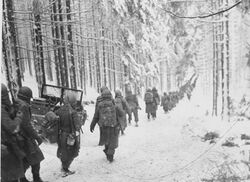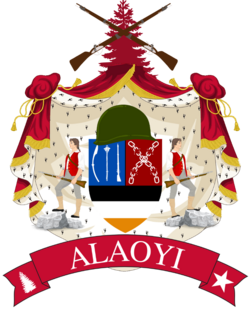Western Alaoyian Front (Second Great War)
| Western Alaoyian Front (Second Great War) | |||||||||
|---|---|---|---|---|---|---|---|---|---|
 Alaoyian soldiers trek through the woods during the Third Battle of Aldsthiem | |||||||||
| |||||||||
| Belligerents | |||||||||
|
|
| ||||||||
| Commanders and leaders | |||||||||
|
|
| ||||||||
| Casualties and losses | |||||||||
|
4-6 million killed 2-3 million captured |
6-8 million killed 3-4 million captured | ||||||||
|
Civilian casualties: 12-15 million killed or wounded | |||||||||
The Galian Theatre was a major theatre of operations during the Second Great War. The vast size of the theatre saw interconnected naval, land, and air campaigns fought for control of the the Great Galian Sea and the Achrinian Ocean. The fighting in this theatre lasted from TBD1938 when Komrep Inglaterra attacked the newly independent Alaoyi and Antarctic Circle States until the end of the war on TBD 1946.
Inglaterra aimed to annex the rest of former Dialand and Inithia, which had been split between the Niagaran and Alannan colonial empires centuries earlier but had remianed a point of contention, while Alaoyian forces aimed initially to retain the status quo. In the south, Inglaterran leadership believed they could successfully annex the Antarctic Circle States. Inglaterran and Alaoyian forces engaged in back and forth fighting across the south Galian steppes. Freezing cold conditions, densely settled territory, and the rough hilly terrain made the combat in the region extraordinarily difficult, bloody, and tiring for the troops involved. By the end of the war, some cities had been fought over up to five or six times and much of the industry and cities of both countries had been destroyed.
The theatre of war had the longest duration of the Second Great War, last virtually the entire war. It had the effect of solidifying Alaoyi's presence as an independent state and indirectly led to the Alaoyian Civil Conflicts, which arose when returing pale veterans were treated poorly by the dominant Alanna-descended leadership of Alaoyi. In Inglaterra, the war solidified the control of the communist government as being the guides of the Inglaterran people. For both countries, the war was characterized by an immense loss of life due to warfare, disease, or exposure and fierce fighting. Due to the stalemates that would arise from the brutal winter months and built up environments, conflict disproportionately occured during the summer months, earning it the nickname "the Summer War".
